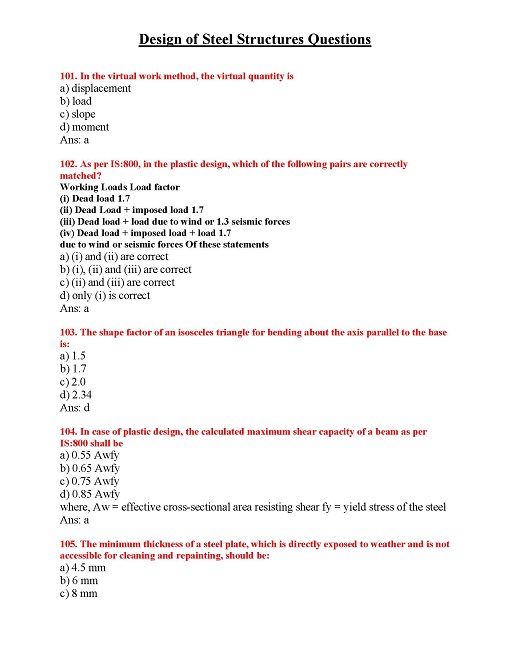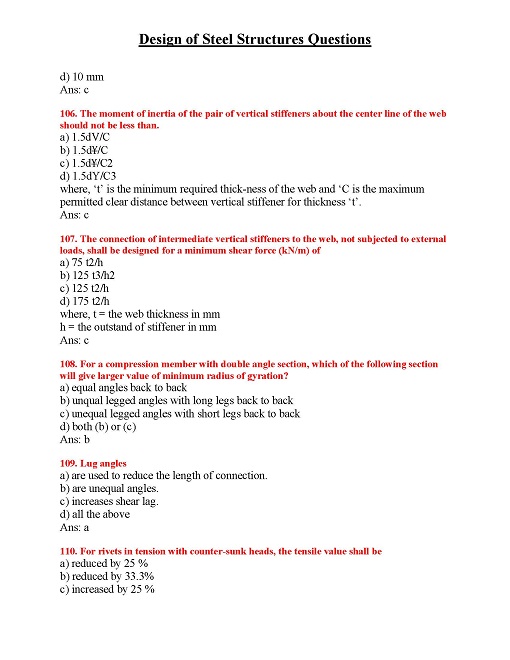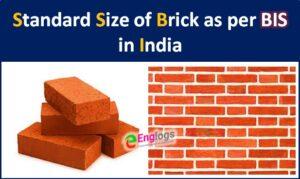Design of Steel Structures Civil Engineering
81. The centrifugal force due to curvature of track is assumed to act on the bridge at a height of
a) 1.23 m above the rail level
b) 1.50 m above the rail level
c) 1.83 m above the rail level
d) 2.13 m above the rail level
Ans: c
82. The effect of racking forces is considered in the design of
i) lateral braces
ii) chord members
The correct answer is
a) only (i)
b) only (ii)
c) both (i) and (ii)
d) none of the above
Ans: a
83. The portal bracing in a truss bridge is used to
a) transfer load from top of end posts to bearings
b) keep the rectangular shape of the bridge cross-section
c) stiffen the structure laterally
d) prevent the sidesway buckling of top chord
Ans: a
84. The sway bracing is designed to transfer
a) 2Vi % of the top panel wind load to bottom bracing
b) 10% of the top panel wind load to bottom bracing
c) 25% of the top panel wind load to bottom bracing
d) 50% of the top panel wind load to bottom bracing
Ans: d
85. Study the following statements.
i) Top lateral bracing prevents the sidesway buckling of the chord.
ii) Sway bracing keeps the rectangular shape of the bridge cross-section.
iii) Sway bracing transfers the load from top of end posts to bearings.
The correct answer is
a) only (i)
b) both (i) and (ii)
c) both (i) and (iii)
d) all (i), (ii) and (iii)
Ans: b
86. The bracing provided in the plane of end posts is called
a) sway bracing
b) portal bracing
c) top lateral bracing
d) bottom lateral bracing
Ans: b
87. compression force in two end posts The pin of a rocker bearing in a bridge is designed for
a) bearing and shear
b) bending and shear
c) bearing and bending
d) bearing, shear and bending
Ans: d

88. The least dimension in case of a circular column of diameter D is taken as
a) 0.5 D
b) 0.68 D
c) 0.88 D
d) D
Ans: c
89. In case of timber structures, the form factor for solid circular cross-section is taken as
a) 1.18
b) 1.414
c) 1.67
d) 1.81
Ans: a
90. In case of timber structures, the simple bending formula M = fz may be applied for
a) rectangular beams up to 300 mm depth
b) all rectangular beams
c) solid circular beams only
d) all square cross-section beams
Ans: a
91. The elastic strain for steel is about
a) 1/12 of strain at the initiation of strain hardening and about 1/120 of maxi-mum strain
b) 1/2 of strain at the initiation of strain hardening and about 1/12 of maxi-mum strain
c) 1/12 of strain at the initiation of strain hardening and 1/200 of maximum strain
d) 1/24 of strain at the initiation of strain hardening and about 1/200 of maximum strain
Ans: c
92. The mechanism method and the statical method give
a) lower and upper bounds respectively on the strength of structure
b) upper and lower bounds respectively on the strength of structure
c) lower bound on the strength of structure
d) upper bound on the strength of structure
Ans: b
93. The moment-curvature relation at a plastic hinge is
a) linear
b) parabolic
c) constant moment for all curvatures
d) constant curvature for all moments
Ans: c
94. Shape factor is a property which depends
a) only on the ultimate stress of the material
b) only on the yield stress of the material
c) only on the geometry of the section
d) both on the yield stress and ultimate stress of material
Ans: c
95. The statical method of plastic analysis satisfies
a) equilibrium and mechanism conditions
b) equilibrium and plastic moment conditions
c) mechanism and plastic moment conditions
d) equilibrium condition only
Ans: b
96. The mechanism method of plastic analysis satisfies
a) equilibrium and mechanism conditions
b) equilibrium and plastic moment conditions
c) mechanism and plastic moment conditions
d) equilibrium condition only
Ans: a
97. Load factor is
a) always equal to factor of safety
b) always less than factor of safety
c) always greater than factor of safety
d) sometimes greater than factor of safety
Ans: c
98. The ratio of plastic section modulus to elastic section modulus
a) is equal to 1
b) is always less than 1
c) is always greater than 1
d) can be less than 1
Ans: c
99. Other conditions being same, the load factor in indeterminate structures is
a) equal to load factor in determinate structures
b) more than the load factor in determinate structures
c) less than the load factor in determinate structures
d) unpredictable
Ans: b
100. Which of the following conditions is to be satisfied both in elastic and plastic analysis ?
a) equilibrium condition
b) yield condition
c) plastic moment condition
d) mechanism condition
Ans: a
101. In the virtual work method, the virtual quantity is
a) displacement
b) load
c) slope
d) moment
Ans: a
102. As per IS:800, in the plastic design, which of the following pairs are correctly matched?
Working Loads Load factor
(i) Dead load 1.7
(ii) Dead Load + imposed load 1.7
(iii) Dead load + load due to wind or 1.3 seismic forces
(iv) Dead load + imposed load + load 1.7
due to wind or seismic forces Of these statements
a) (i) and (ii) are correct
b) (i), (ii) and (iii) are correct
c) (ii) and (iii) are correct
d) only (i) is correct
Ans: a
103. The shape factor of an isosceles triangle for bending about the axis parallel to the base is:
a) 1.5
b) 1.7
c) 2.0
d) 2.34
Ans: d

104. In case of plastic design, the calculated maximum shear capacity of a beam as per IS:800 shall be
a) 0.55 Awfy
b) 0.65 Awfy
c) 0.75 Awfy
d) 0.85 Awfy
where, Aw = effective cross-sectional area resisting shear fy = yield stress of the steel
Ans: a
105. The minimum thickness of a steel plate, which is directly exposed to weather and is not accessible for cleaning and repainting, should be:
a) 4.5 mm
b) 6 mm
c) 8 mm
d) 10 mm
Ans: c
106. The moment of inertia of the pair of vertical stiffeners about the center line of the web should not be less than.
a) 1.5dV/C
b) 1.5d¥/C
c) 1.5d¥/C2
d) 1.5dY/C3
where, ‘t’ is the minimum required thick-ness of the web and ‘C is the maximum permitted clear distance between vertical stiffener for thickness ‘t’.
Ans: c
107. The connection of intermediate vertical stiffeners to the web, not subjected to external loads, shall be designed for a minimum shear force (kN/m) of
a) 75 t2/h
b) 125 t3/h2
c) 125 t2/h
d) 175 t2/h
where, t = the web thickness in mm
h = the outstand of stiffener in mm
Ans: c
108. For a compression member with double angle section, which of the following section will give larger value of minimum radius of gyration?
a) equal angles back to back
b) unqual legged angles with long legs back to back
c) unequal legged angles with short legs back to back
d) both (b) or (c)
Ans: b
109. Lug angles
a) are used to reduce the length of connection.
b) are unequal angles.
c) increases shear lag.
d) all the above
Ans: a
110. For rivets in tension with counter-sunk heads, the tensile value shall be
a) reduced by 25 %
b) reduced by 33.3%
c) increased by 25 %
d) increased by 33.3 %
Ans: b
111. A steel beam supporting loads from the floor slab as well as from wall is termed as
a) stringer beam
b) lintel beam
c) spandrel beam
d) header beam
Ans: c
112. Pitch of tacking rivets, when double angles connected back to back and acting as tension members should not be more than
a) 500 mm
b) 600 mm
c) 1000 mm
d) 300 mm
Ans: c
113. In moment resistant connections, the moment resistance of riveted connection depends upon
a) shear in rivets
b) compression in rivets
c) tension in rivets
d) strength of rivets in bearing
Ans: c
120. The allowable shear stress in the web of mild steel beams decreases with
a) decrease in h/t ratio
b) increase in h/t ratio
c) decrease in thickness
d) increase in height
where ‘h’ is height and t is thickness
Ans: b
You may also like:
- ARAMCO :: CBT QA/QC – Instrumentation Inspector Qualification Guideline
- PIPING Inspector Qualification Guideline Vol-2
- Saudi Aramco Cbt Exam Questions and Answers
- CBT EXAM E-BOOKS
- QA/QC ELECTRICAL Inspector Question & Answer Handbooks
- QA/QC E-books Category
- WELDING PROCEDURES (WPS) Neptune Energy Netherlands
- What is Pipe Rack?
- Building Materials Civil – Engineering Questions Answers Part-1
- Building Materials Civil – Engineering Questions Answers Part-2
- Design of Steel Structures Civil Questions and Answer Part-1
- Design of Steel Structures Civil Questions and Answer Part-2



